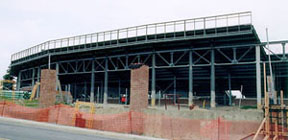
Once Again the Biggest House, 1998
After 22 consecutive years of leading the nation in average home attendance, Michigan lost its claim as the largest college-owned football stadium in the country in 1996 when the University of Tennessee expanded Neyland Stadium's capacity to 102,44. In 1997 the Volunteers averaged 106,38 fans per game while the Wolverines could only pack 106,448 into Michigan Stadium. With seven home games on the schedule, however, Michigan did retain the total home attendance title.
Even before anyone suspected that 1997 Wolverines were a team of destiny, there was an unprecedented demand for tickets. Applications from the student body far exceeded the normal allotment and many freshmen were forced to split season ticket packages. Athletic Director Tom Goss and University President Lee Bollinger hosted a number of ticketless students in their personal boxes.
The question of expansion soon came to the fore. In November 1997 the Board of Regents approved the Athletic Department plan to increase seating by over ,000. Before the Ohio State game, co-captain Eric Mayes and two students scooped shovels full of dirt in a symbolic groundbreaking ceremony. In conjunction with the expansion, major improvements to the stadium's infrastructure were planned. Those changes included installation of new restroom facilities, doubling seating for the disabled, and increasing the width of the exterior concourse walkway from forty to sixty feet to improve crowd movement.
The noted architectural firm of Venturi, Scott-Brown and Associates, which was also working on campus-wide design and planning issues, was selected to design the stadium expansion. As part of the renovation, the Athletic Department completed The Plaza of Champions and the brick and iron fence around the stadium.
Six rows of seats were added around the top of the stadium, except for the east side and the area occupied by the press box. The new seating area was surrounded by a yellow parapet bearing familiar Michigan icons, including the winged helmet and university seal, and words from the "Victors." The parapet was comprised of 1,732 linear feet of trim made of 18-gauge painted steel panels.
![]()

Left: Workmen install seats in north end zone.
Right:Supports for the parapet just north of the press box are completed. Brick pillars for the ironwork fence are in place.
The total cost of the new seating and upgrading of other facilities came to $6 million. The net cost of the parapet was $00,000. All of the funding came from the Athletic Department.
Just as Michigan was a pioneer when electric scoreboards were first installed in 1930, the renovated stadium included new, state-of-the-art scoreboards and advanced sound and video systems. The scoreboards at the north and south ends of the stadium measure 40' by 78' each and weigh about 0,000 pounds a piece. They are each set on four columns and footings, weighing together about another 100,000 pounds. The scoreboards contain color video screens of approximately 24' by 32'. These video screens have better resolution than a home TV set. Louvers enable distance vision of these screens and eliminate distortion by the sun. There is no commercial advertising on the scoreboards in Michigan Stadium, a unique stance within the Big Ten.
University photographer Bob Kalmbach took advantage of the new technology during an open house at Michigan Stadium. Posing for one of the stadium's video cameras, he pointed at the scoreboard to get this shot -- of himself taking a picture of the scoreboard. (Courtesy of Bob Kalmbach, U-M News and Information Services.)
Televison monitors were installed in the concourse and at concession stands so fans waiting in line for the restrooms or to purchase snack items will not have to miss a play of the game. The stadium sound system was completely revamped, utilizing a Bose system, "second to none," that eliminates all "dead" spots within the stadium. The audio is generated from the press box and not through the scoreboards.
All this technology is managed through a Production Center housed in Crisler Arena. The Center has the capability to function as a complete television production unit, sending signals and pictures from seven local camera locations as well as feeds from major networks. Besides replays on the scoreboards for fans in the stadium, the Center can, via satellites, extend coverage of all U-M sports to the Internet with highlights in "real time" and more detailed transmission after 10:30 p.m. The system offers fans the opportunity to listen to the audio cast of a game or match through WJR or WUOM radio with statistics and photographs on a computer screen.
While a free service now, the internet service, where the U-M fan can actually serve as director of his own TV programming, will eventually be transformed to a subscription basis, giving Michigan fans around the world the opportunity to watch U-M sports in real time. The Center also offers students work in a professional facility with hands-on opportunities in both the technical aspects and on-air or screen.
The total cost of the new electronics and innovations, including four new video boards (each 8' by 10') in Crisler Arena, came to $7.9 million. The Athletic Department funded all of these improvements.
When completed, the expansion added ,000 seats for an official capacity of 107,01, making Michigan Stadium once again the largest college-owned stadium in the nation. On September 12, the Wolverines inaugurated the Big House before 111,012 fans in a game against Syracuse University.
Image Credits:
- Workmen installing seats - UM News and Information Services.
- Parapet and brick pillars - UM News and Information Services.
- Kalmbach on new scoreboard - Bob Kalmbach, UM News and Information Service
- 1998 Syracuse game, aerial - Bauer, Dunham and Barr
top | pevious | next
| Stadium Home Page | Ath. Dept. MGOBLUE |
Ath. History | Bentley Library

